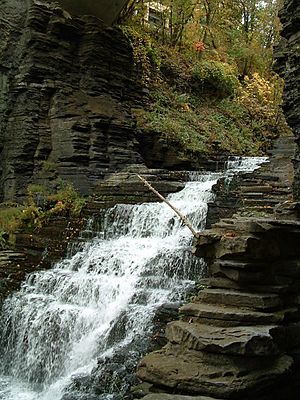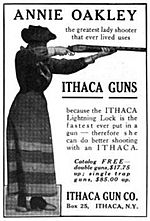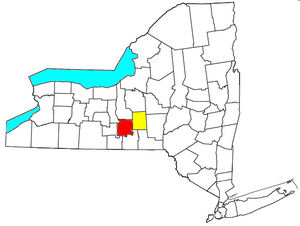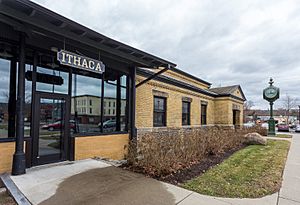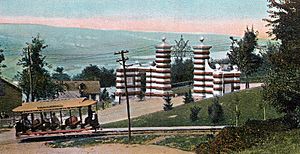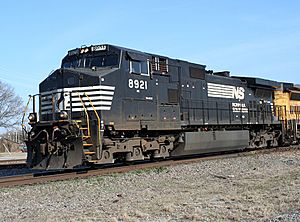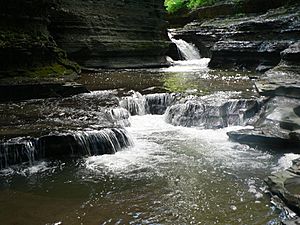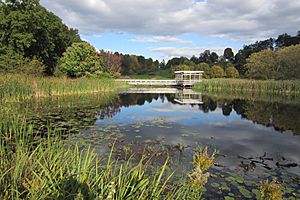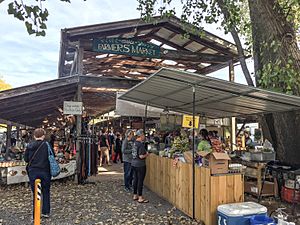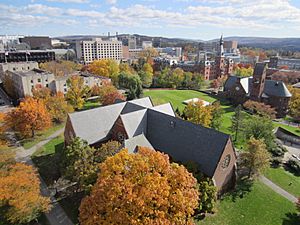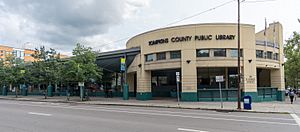Ithaca, New York facts for kids
Quick facts for kids
Ithaca
|
|
|---|---|
|
City
|
|
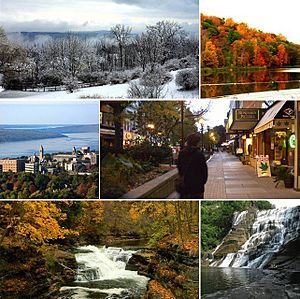
Clockwise from top left: Ithaca during winter, Ithaca during autumn, Ithaca Commons (downtown), Ithaca Falls, Hemlock Gorge, Cornell University.
|
|
| Country | |
| State | |
| County | Tompkins |
| Founded | 1790 |
| Incorporated | 1888 |
| Named for | Ithaca |
| Government | |
| • Type | Mayor–council |
| • Body | Common Council |
| Area | |
| • City | 6.07 sq mi (15.72 km2) |
| • Land | 5.39 sq mi (13.96 km2) |
| • Water | 0.68 sq mi (1.77 km2) |
| • Urban | 24.581 sq mi (63.66 km2) |
| • Metro | 474.649 sq mi (1,229.34 km2) |
| Elevation | 404 ft (123 m) |
| Population
(2020) † City proper.
|
|
| • City | 32,108 |
| • Density | 5,956.96/sq mi (2,300/km2) |
| • Urban | 53,661 |
| • Urban density | 2,183.03/sq mi (842.872/km2) |
| • Metro | 105,740 |
| • Metro density | 222.775/sq mi (86.014/km2) |
| Demonym(s) | Ithacan |
| Time zone | UTC−5 (EST) |
| • Summer (DST) | UTC−4 (EDT) |
| ZIP Codes |
14850, 14851, 14852, and 14853
|
| Area code(s) | 607 |
| FIPS code | 36-38077 |
| GNIS feature IDs | 970238, 979099 |
Ithaca is a city in the Finger Lakes region of New York, United States. Situated on the southern shore of Cayuga Lake, Ithaca is the seat of Tompkins County and the largest community in the Ithaca metropolitan statistical area. It is named after the Greek island of Ithaca.
A college town, Ithaca is home to Cornell University and Ithaca College. Nearby is Tompkins Cortland Community College (TC3). These three colleges bring thousands of students to the area, who increase Ithaca's seasonal population during the school year. As of 2020, the city's population was 32,108.
Contents
History
Early history
Indigenous people occupied this area for thousands of years. At the time of European contact, this area was controlled by the Cayuga Indians, one of the powerful Five Nations of the Haudenosaunee or Iroquois League. Jesuit missionaries from New France (Quebec) are said to have had a mission to the Cayuga as early as 1657.
Saponi and Tutelo Indians, Algonquian-speaking tribes, later occupied lands at the south end of Cayuga Lake. Dependent tributaries of the Cayuga, they had been permitted to settle on the tribe's hunting lands at the south end of Cayuga Lake, as well as in Pony (originally Sapony) Hollow of what is known as present-day Newfield, New York. Remnants of these tribes had been forced from North Carolina by tribal conflicts and European colonial encroachment. Similarly, the Tuscarora people, an Iroquoian-speaking tribe from the Carolinas, migrated after defeat in the Yamasee War; they settled with the Oneida people and became the sixth nation of the Haudenosaunee, with chiefs stating the migration was complete in 1722.
During the Revolutionary War, four of the then six Iroquois nations were allied with the British, although bands made decisions on fighting in a highly decentralized way. Conflict with the rebel colonists was fierce throughout the Mohawk Valley and western New York. In retaliation for conflicts to the east, the 1779 Sullivan Expedition was conducted against the Iroquois peoples in the west of the state, destroying more than 40 villages and stored winter crops. It destroyed the Tutelo village of Coregonal, located near what is now the junction of state routes 13 and 13A just south of the Ithaca city limits. Most Iroquois were forced from the state after the Revolutionary War, but some remnants remained. The state sold off the former Iroquois lands to stimulate development and settlement by European Americans; lands were also granted as payment to veterans of the war.
Within the current boundaries of the City of Ithaca, Native Americans maintained only a temporary hunting camp at the base of Cascadilla Gorge. In 1788 eleven men from Kingston, New York came to the area with two Delaware people (Lenape) guides, to explore what they considered wilderness. The following year Jacob Yaple, Isaac Dumond, and Peter Hinepaw returned with their families and constructed log cabins. That same year Abraham Bloodgood of Albany obtained a patent from the state for 1400 acres, which included all of the present downtown west of Tioga Street. In 1790, the federal government and state began an official program to grant land in the area, known as the Central New York Military Tract, as payment for service to the American soldiers of the Revolutionary War, as the government was cash poor. Most local land titles trace back to these Revolutionary war grants.
Partition of the Military Tract
As part of this process, the Central New York Military Tract, which included northern Tompkins County, was surveyed by Simeon De Witt, Bloodgood's son-in-law. De Witt was also the nephew of Governor George Clinton. The Commissioners of Lands of New York State (chairman Gov. George Clinton) met in 1790. The Military Tract township in which proto-Ithaca was located was named the Town of Ulysses. A few years later De Witt moved to Ithaca, then called variously "The Flats," "The City," or "Sodom"; he renamed it for the Greek island home of Ulysses in the spirit of the multitude of settlement names in the region derived from classical literature, such as Aurelius, Ovid, and especially of Ulysses, New York, the town that contained Ithaca at the time.
Around 1791 De Witt surveyed was is now the present downtown area into lots and sold them at modest prices. That same year John Yaple built a grist mill on Cascadilla Creek. The first frame house was erected in 1800 by Abram Markle. In 1804 the village had a postmaster, and in 1805 a tavern.
Growth
Ithaca became a transshipping point for salt from curing beds near Salina, New York to buyers south and east. This prompted construction in 1810 of the Owego Turnpike. When the War of 1812 cut off access to Nova Scotia gypsum, used for fertilizer, Ithaca became the center of trade in Cayuga gypsum. The Cayuga Steamboat Company was organized in 1819 and in 1820 launched the first steamboat on Cayuga Lake, the Enterprise. In 1821, the village was incorporated at the same time the Town of Ithaca was organized and separated from the parent Town of Ulysses. In 1834, the Ithaca and Owego Railroad's first horse-drawn train began service, connecting traffic on the east-west Erie Canal (completed in 1825) with the Susquehanna River to the south to expand the trade network.
With the depression of 1837, the railroad was re-organized as the Cayuga & Susquehanna. It was re-engineered with switchbacks in the late 1840s; much of this route in the late 20th century was converted to trails under the Rails to Trails program; it is used by the South Hill Recreation Way.
However, easier railroad routes were constructed, such as that of the Syracuse, Binghamton & New York (1854). In the decade following the Civil War, railroads were built from Ithaca to surrounding points (Geneva; Cayuga; Cortland; and Elmira, New York; and Athens, Pennsylvania), mainly with financing from Ezra Cornell. The geography of the city, on a steep hill by the lake, has prevented it from being directly connected to a major transportation artery. When the Lehigh Valley Railroad built its main line from Pennsylvania to Buffalo, New York in 1890, it bypassed Ithaca (running via eastern Schuyler County on easier grades), as the Delaware, Lackawanna and Western Railroad had done in the 1850s.
In the late 19th century, more industry developed in Ithaca. In 1883 William Henry Baker and his partners started the Ithaca Gun Company, making shotguns. The original factory was located in the Fall Creek neighborhood of the city, on a slope later known as Gun Hill, where the nearby waterfall supplied the main source of energy for the plant. The company became an icon in the hunting and shooting world, its shotguns famous for their fine decorative work. Wooden gunstocks with knots or other imperfections were donated to the high school woodworking shop to be made into lamps. John Philip Sousa and trick-shooter Annie Oakley favored Ithaca guns. In 1937 the company began producing the Ithaca 37, based on a 1915 patent by noted firearms designer John Browning. Its 12-gauge shotguns were the standard used for decades by the New York Police Department and Los Angeles Police Department.
In 1885, Ithaca Children's Home was established on West State Street. The orphanage had two programs at the time: a residential home for both orphaned and destitute children, and a day nursery. The village established its first trolley in 1887. Ithaca developed as a small manufacturing and retail center and was incorporated as a city in 1888. The largest industrial company in the area was Morse Chain, elements of which were absorbed into Emerson Power Transmission on South Hill and Borg Warner Automotive in Lansing, New York.
Ithaca claims to be the birthplace of the ice cream sundae, created in 1892 when fountain shop owner Chester Platt "served his local priest vanilla ice cream covered in cherry syrup with a dark candied cherry on top. The priest suggested the dessert be named after the day, Sunday — although the spelling was later changed out of fear some would find it offensive." The local Unitarian church, where the priest, Rev. John Scott, preached, has an annual "Sundae Sunday" every September in commemoration. Ithaca's claim has long been disputed by Two Rivers, Wisconsin. Also in 1892, the Ithaca Kitty became one of the first mass-produced stuffed animal toys in the United States.
In 1903 a typhoid epidemic, resulting from poor sanitation infrastructure, devastated the city. One out of 10 citizens fell ill or died.
In 1900 Cornell anatomy professor G.S. Moler made an early movie using frame-by-frame technology. For The Skeleton Dance, he took single-frame photos of a human skeleton in varying positions, giving the illusion of a dancing skeleton. During the early 20th century, Ithaca was an important center in the silent film industry. These films often featured the local natural scenery. Many of these films were the work of Leopold Wharton and his brother Theodore; their studio was on the site of what is now Stewart Park.
The Star Theatre on East Seneca Street was built in 1911 and became the most popular vaudeville venue in the region. Wharton movies were also filmed and shown there. After the film industry centralized in Hollywood, production in Ithaca effectively ceased. Few of the silent films made in Ithaca have been preserved.
After World War II, the Langmuir Research Labs of General Electric developed as a major employer; the defense industry continued to expand. GE's headquarters were based in Schenectady, New York, to the east in the Mohawk Valley.
Recent history

For decades, the Ithaca Gun Company tested their shotguns behind the plant on Lake Street; the shot fell into Fall Creek (a tributary of Cayuga Lake) at the base of Ithaca Falls. Lead contaminated the water supply, air and land. A major lead clean-up effort sponsored by the United States Superfund took place from 2002 to 2004, managed through the Environmental Protection Agency. The old Ithaca Gun building has been dismantled. It was scheduled to be replaced by development of an apartment complex on the cleaned land.
The former Morse Chain company factory on South Hill, now owned by Emerson Power Transmission, was the site of extensive groundwater and soil contamination from its industrial operations. Emerson Power Transmission has been working with the state and South Hill residents to determine the extent and danger of the contamination and aid in cleanup.
In 2004, Gayraud Townsend, a 20-year-old senior in Cornell's School of Industrial and Labor Relations, was sworn in as alderman of the city council, the first black male to be elected to the council and the youngest African American to be elected to office in the United States. He served his full term and has mentored other student politicians. In 2011 Cornell Class of 2009 graduate Svante Myrick was elected as the youngest mayor of the city of Ithaca.
Geography and climate
Geography
The valley in which Cayuga Lake is located is long and narrow with a north-south orientation. Ithaca is at the southern end (the "head") of the lake, but the valley continues to the southwest behind the city. Originally a river valley, it was deepened and widened by the action of Pleistocene ice sheets over the last several hundred thousand years. The lake, which drains to the north, formed behind a dam of glacial moraine. The rock is predominantly Devonian and, north of Ithaca, is relatively fossil rich. Glacial erratics can be found in the area. The world-renowned fossils found in this area can be examined at the Museum of the Earth.
Ithaca was founded on flat land just south of the lake — land that formed in fairly recent geological times when silt filled the southern end of the lake. The city ultimately spread to the adjacent hillsides, which rise several hundred feet above the central flats: East Hill, West Hill, and South Hill. Its sides are fairly steep, and a number of the streams that flow into the valley from east or west have cut deep canyons, usually with several waterfalls.
The natural vegetation of the Ithaca area, seen in areas unbuilt and unfarmed, is northern temperate broadleaf forest, dominated by deciduous trees.
Climate
| Weather chart for Ithaca | |||||||||||||||||||||||||||||||||||||||||||||||
|---|---|---|---|---|---|---|---|---|---|---|---|---|---|---|---|---|---|---|---|---|---|---|---|---|---|---|---|---|---|---|---|---|---|---|---|---|---|---|---|---|---|---|---|---|---|---|---|
| J | F | M | A | M | J | J | A | S | O | N | D | ||||||||||||||||||||||||||||||||||||
|
2
32
16
|
1.9
33
15
|
2.6
42
24
|
2.9
55
35
|
3.3
67
45
|
3.6
76
54
|
3.6
81
58
|
3.5
79
57
|
3.4
72
50
|
3.1
60
40
|
2.7
47
32
|
2.4
35
21
|
||||||||||||||||||||||||||||||||||||
| temperatures in °F precipitation totals in inches |
|||||||||||||||||||||||||||||||||||||||||||||||
|
Metric conversion
|
|||||||||||||||||||||||||||||||||||||||||||||||
Ithaca experiences a moderate continental climate. Winters are long, cold, and snowy, with temperatures reaching 0 °F (−18 °C) or lower on an average 9.9 nights annually and an average of 67 in (170 cm) of snow per season. The largest snowfall in one day was 26.0 in (66 cm) on February 14, 1914. Summers are warm and humid, with usually comfortable temperatures. Readings of 90 °F (32 °C) or higher occur on an average of just 5.2 days per year, and 100 °F (38 °C)+ temperatures have only occurred ten times since record-keeping began in 1893. The average date of the first freeze is October 5, and the average date of the last freeze is May 15, giving Ithaca a growing season of 141 days. The average date of the first and last snowfalls are November 12 and April 7, respectively. Extreme temperatures range from −25 °F (−32 °C) as recently as February 2, 1961 up to 103 °F (39 °C) on July 9, 1936.
The valley flatland has slightly milder weather in winter, and occasionally Ithacans experience simultaneous snow on the hills and rain in the valley. The phenomenon of mixed precipitation (rain, wind, and snow), common in the late fall and early spring, is known tongue-in-cheek as ithacation to many of the local residents.
Due to the microclimates created by the impact of the lakes, the region surrounding Ithaca (Finger Lakes American Viticultural Area) experiences a short but adequate growing season for winemaking similar to the Rhine Valley wine district of Germany. As such, the region is home to many wineries.
| Climate data for Ithaca, New York (Cornell University), 1893–2012 | |||||||||||||
|---|---|---|---|---|---|---|---|---|---|---|---|---|---|
| Month | Jan | Feb | Mar | Apr | May | Jun | Jul | Aug | Sep | Oct | Nov | Dec | Year |
| Record high °F (°C) | 70 (21) |
67 (19) |
85 (29) |
91 (33) |
96 (36) |
102 (39) |
103 (39) |
101 (38) |
100 (38) |
91 (33) |
81 (27) |
69 (21) |
103 (39) |
| Average high °F (°C) | 31.6 (−0.2) |
32.5 (0.3) |
41.7 (5.4) |
54.8 (12.7) |
67.1 (19.5) |
76.2 (24.6) |
80.9 (27.2) |
78.9 (26.1) |
71.8 (22.1) |
60.0 (15.6) |
47.2 (8.4) |
35.3 (1.8) |
56.5 (13.6) |
| Average low °F (°C) | 15.7 (−9.1) |
15.2 (−9.3) |
24.0 (−4.4) |
34.7 (1.5) |
44.6 (7.0) |
53.8 (12.1) |
58.4 (14.7) |
56.7 (13.7) |
50.1 (10.1) |
40.0 (4.4) |
31.8 (−0.1) |
21.0 (−6.1) |
37.2 (2.9) |
| Record low °F (°C) | −25 (−32) |
−25 (−32) |
−17 (−27) |
11 (−12) |
22 (−6) |
31 (−1) |
38 (3) |
32 (0) |
24 (−4) |
15 (−9) |
−4 (−20) |
−22 (−30) |
−25 (−32) |
| Average precipitation inches (mm) | 2.01 (51) |
1.94 (49) |
2.62 (67) |
2.89 (73) |
3.33 (85) |
3.64 (92) |
3.61 (92) |
3.50 (89) |
3.41 (87) |
3.12 (79) |
2.65 (67) |
2.41 (61) |
35.14 (893) |
| Average snowfall inches (cm) | 15.5 (39) |
14.5 (37) |
11.9 (30) |
3.9 (9.9) |
.1 (0.25) |
0 (0) |
0 (0) |
0 (0) |
0 (0) |
.4 (1.0) |
4.9 (12) |
13.2 (34) |
64.3 (163) |
| Average precipitation days (≥ .01 inch) | 15 | 13 | 14 | 14 | 14 | 12 | 12 | 11 | 11 | 12 | 13 | 15 | 156 |
| Source: Western Regional Climate Center | |||||||||||||
Demographics
| Historical population | |||
|---|---|---|---|
| Census | Pop. | %± | |
| 1870 | 8,462 | — | |
| 1880 | 9,105 | 7.6% | |
| 1890 | 11,079 | 21.7% | |
| 1900 | 13,136 | 18.6% | |
| 1910 | 14,802 | 12.7% | |
| 1920 | 17,004 | 14.9% | |
| 1930 | 20,708 | 21.8% | |
| 1940 | 19,730 | −4.7% | |
| 1950 | 29,257 | 48.3% | |
| 1960 | 28,732 | −1.8% | |
| 1970 | 26,226 | −8.7% | |
| 1980 | 28,799 | 9.8% | |
| 1990 | 29,541 | 2.6% | |
| 2000 | 29,287 | −0.9% | |
| 2010 | 30,014 | 2.5% | |
| 2020 | 32,108 | 7.0% | |
| U.S. Decennial Census | |||
Ithaca is the principal city of the Ithaca-Cortland Combined Statistical Area, which includes the Ithaca Metropolitan Statistical Area (Tompkins County) and the Cortland Micropolitan Statistical Area (Cortland County), which had a combined population of 145,100 at the 2000 census.
As of the census of 2000, there were 29,287 people, 10,287 households, and 2,962 families residing in the city. The population density was 5,360.9 people per square mile (2,071.0/km2). There were 10,736 housing units at an average density of 1,965.2 per square mile (759.2/km2). The racial makeup of the city was 73.97% White, 13.65% Asian, 6.71% Black or African American, 0.39% Native American, 0.05% Pacific Islander, 1.86% from other races, and 3.36% from two or more races. Hispanic or Latino of any race were 5.31% of the population.
There were 10,287 households, out of which 14.2% had children under the age of 18 living with them, 19.0% were married couples living together, 7.8% had a female householder with no husband present, and 71.2% were non-families. 43.3% of all households were made up of individuals, and 7.4% had someone living alone who was 65 years of age or older. The average household size was 2.13 and the average family size was 2.81.
In the city, the population was spread out, with 9.2% under the age of 18, 53.8% from 18 to 24, 20.1% from 25 to 44, 10.6% from 45 to 64, and 6.3% who were 65 years of age or older. The median age was 22 years. For every 100 females, there were 102.6 males. For every 100 females age 18 and over, there were 102.2 males.
The median income for a household in the city was $21,441, and the median income for a family was $42,304. Males had a median income of $29,562 versus $27,828 for females. The per capita income for the city was $13,408. About 13.2% of individuals and 4.2% of families were below the poverty line.
Greater Ithaca
The term "Greater Ithaca" encompasses both the City and Town of Ithaca, as well as several smaller settled places within or adjacent to the Town:
Municipalities
- Village of Groton
- Village of Lansing
- the southern part of the Town of Lansing
- Village of Cayuga Heights
- Hamlet of Forest Home
- Hamlet of South Hill
Culture
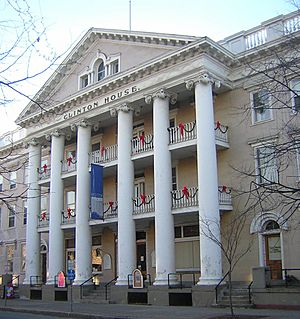
Founded in 1983, the Sciencenter, is a non-profit hands-on science museum, accredited by the American Alliance of Museums (AAM) and is a member of the Association of Science-Technology Centers (ASTC) and Association of Children’s Museums (ACM).
The Museum of the Earth is a natural history museum created in 2003 by the Paleontological Research Institution (PRI). The PRI was founded in Ithaca in 1932 and is the publisher of the oldest journal of paleontology in the western hemisphere. Exhibits cover the 4.5 billion year history of the earth in an accessible manner, including interactive displays. As of 2004, the PRI is now formally affiliated with Cornell.
The Cayuga Nature Center occupies the site of the 1914 Cayuga Preventorium, a facility for children with tuberculosis; treatment of what was then considered an incurable disease was based on rest and good nutrition. In 1981, the Cayuga Nature Center was incorporated as an independent, private, non-profit educational organization, offering environmental education to local school districts. In 2011, the PRI merged with the Cayuga Nature Center, making it a sister organization to the Museum of the Earth.
The Cornell Lab of Ornithology is located in the Imogene Powers Johnson Center for Birds and Biodiversity. The Lab's Visitors' Center and observation areas are open to the public. Displays include a surround sound theater, object-theater presentation, sound studio, and informational kiosks featuring bird sounds and information.
The Herbert F. Johnson Museum of Art houses one of the finest collections of art in upstate New York. Special exhibitions are mounted each year, plus selections from a global permanent collection, which is displayed on six public floors. The collection includes art from throughout Asia, Africa, Europe, the Americas, graphic arts, medallic art, and Tiffany glass, ranging from the ancient to the contemporary.
The Center for the Arts at Ithaca, Inc., operates the "Hangar Theatre". Opened in 1975 in a renovated municipal airport hangar, the Hangar hosts a summer season and brings a range of theatre to regional audiences including students, producing a school tour and Artists-in-the-Schools programs. Ithaca is also the home to Kitchen Theatre Company, a non-profit professional company with a theatre on West State Street; and Civic Ensemble, a creative collaborative ensemble staging emerging playwrights' work and community-based original productions.
Ithaca is noted for its annual community celebration, The Ithaca Festival. The Constance Saltonstall Foundation for the Arts provides grants and summer fellowships at the Saltonstall Arts Colony for New York State artists and writers. Ithaca also hosts one of the largest used-book sales in the United States.
The city and town also sponsor The Apple Festival in the fall, the Chili Fest in February, the Finger Lakes International Dragon Boat Festival in July; Porchfest in late September, and the Ithaca Brew Fest in Stewart Park in September.
Ithaca has also pioneered the Ithaca Health Fund, a popular cooperative health insurance. Ithaca is home to one of the United States' first local currency systems, Ithaca Hours, developed by Paul Glover.
Music
Ithaca is the home of the Cayuga Chamber Orchestra.
The Cornell Concert Series has been hosting musicians and ensembles of international stature since 1903. For its initial 84 years, the series featured Western classical artists exclusively. In 1987, however, the series broke with tradition to present Ravi Shankar and has since grown to encompass a broader spectrum of the world’s great musics. Now, it balances of a mix of Western classical music, traditions from around the world, jazz, and new musics in these genres. In a single season, Cornell Concert Series presents performers ranging from the Leipzig Tomanerchor and Danish Quartet to Simon Shaheen, Vida Guitar Quartet, and Eighth Blackbird.
The School of Music at Ithaca College was founded in 1892 by William Egbert as a music conservatory on Buffalo Street. Among the degree programs offered are those in Performance, Theory, Music Education, and Composition. Since 1941, the School of Music has been accredited by the National Association of Schools of Music.
Ithaca's Suzuki school, Ithaca Talent Education, provides musical training for children of all ages and also teacher training for undergraduate and graduate-level students. The Community School of Music and Art uses an extensive scholarship system to offer classes and lessons to any student, regardless of age, background, economic status, or artistic ability.
A number of musicians call Ithaca home, most notably Samite of Uganda, The Burns Sisters, The Horse Flies, Johnny Dowd, Mary Lorson, cellist Hank Roberts, reggae band John Brown's Body and X Ambassadors. Old-time music is a staple and folk music is featured weekly on WVBR-FM's Bound for Glory, North America's longest-running live folk concert broadcast. The Finger Lakes GrassRoots Festival of Music and Dance, hosted by local band Donna the Buffalo, is held annually during the third week in July in the nearby village of Trumansburg, with more than 60 local, national and international acts.
In popular culture
Books
- My Education by Susan Choi (Though the college town setting is never named, readers familiar with Ithaca will note its extensive and obvious similarities)
- This Beautiful Life by Helen Shulman (Main character and her family moved from Ithaca to NYC)
- New Moon by Stephenie Meyer (Carlisle and Esme Cullen studied at Cornell University during the period of time that the Cullens moved away from Forks, Washington and during Edward's and Bella's breakup)
- Lolita by Vladimir Nabokov (schoolgirl dialog captured on Ithaca city buses)
- Pnin by Vladimir Nabokov ('Waindell University' a portrait of Cornell)
- The War Between the Tates by Alison Lurie ('Corinth University', a thinly-disguised portrait of Cornell)
- Been Down So Long It Looks Like Up to Me by Richard Fariña ('Mentor University', same as above)
- The Widening Stain by Morris Bishop
- The Names of the Dead by Stewart O'Nan
- Enchantment by Orson Scott Card (partially set in Ithaca and fictional nearby towns)
- Various Kurt Vonnegut books have Ithaca references, most notably Player Piano, Slaughterhouse-Five, Hocus Pocus, and Cat's Cradle
- Fool on the Hill by Matt Ruff
- The Emigrants by W. G. Sebald
- We Were the Mulvaneys by Joyce Carol Oates
- Mailman by J. Robert Lennon takes place in a fictionalized Ithaca known as Nestor
- Z For Zachariah by Robert C. O'Brien
- Between Two Fires by Nicholas Nicastro describes scenes in and around the site of Ithaca during the Revolutionary War
- Water for Elephants by Sara Gruen (the main character, Jacob, was a Cornell University veterinary student)
Movies and television shows
- The Three Stooges Meet Hercules (1962) – dir. Edward Bernds
- Being Human — Main character Josh Levinson is from Ithaca and returns in episode 107 "I See Your True Colors... And That's Why I Hate You"
- Green Lights (2002) — dir. Robert H. Lieberman
- House of Cards (U.S. TV series) (2016) - Janine Skorsky leaves Washington to teach college courses in Ithaca
- The Manhattan Project — dir. Marshall Brickman
- Road Trip (2000) — dir. Todd Phillips
- The Sure Thing (1985) — dir. Rob Reiner
- Waiting on Alphie (2005) — dir. Kevin Hicks
See also The Whartons Studio for films shot in Ithaca prior to 1920.
Transportation
In 2009, the Ithaca metropolitan statistical area (MSA) ranked as the highest in the United States for the percentage of commuters who walked to work (15.1 percent). In 2013, the Ithaca MSA ranked as the second-lowest in the United States for percentage of commuters who traveled by private vehicle (68.7 percent). During the same year, 17.5 percent of commuters in the Ithaca MSA walked to work.
Roads
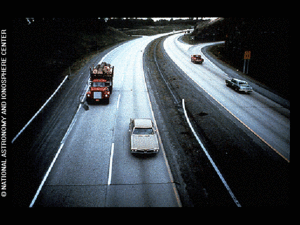
Ithaca is in the rural Finger Lakes region about 225 miles (362 km) northwest of New York City; the nearest larger cities, Binghamton and Syracuse, are an hour's drive away by car, Rochester and Scranton are two hours, Buffalo and Albany are three. New York City, Philadelphia, Toronto, and Ottawa are about four hours away.
Ithaca lies at over a half-hour's drive from any interstate highway, and all car trips to Ithaca involve some driving on two-lane state rural highways. The city is at the convergence of many regional two-lane state highways: Routes 13, 13A, 34, 79, 89, 96, 96B and 366. These are usually not congested except in Ithaca proper. However, Route 79 between the I-81 access at Whitney Point and Ithaca receives a significant amount of Ithaca-bound congestion right before Ithaca's colleges reopen after breaks.
In July, 2008, a non-profit called Ithaca Carshare began a carsharing service in Ithaca. Ithaca Carshare has a fleet of vehicles shared by over 1500 members as of July, 2015 and has become a popular service among both city residents and the college communities. Vehicles are located throughout Ithaca downtown and at the two major institutions. With Ithaca Carshare as the first locally-run carsharing organization in New York State, others have since launched in Buffalo, Albany, and Syracuse.
Rideshare services to promote carpooling and vanpooling are operated by ZIMRIDE and VRIDE. A community mobility education program, Way2Go, is operated by Cornell Cooperative Extension of Tompkins County. Way2Go's website provides consumer information and videos. Way2Go works collaboratively to help people save money, stress less, go green and improve mobility options. The 2-1-1 Tompkins/Cortland Help line connects people with services, including transportation, in the community, by telephone and web on a 24/7 basis. The information and referral service is operated by the Human Services Coalition of Tompkins County, Inc. Together, 2-1-1 Information and Referral and Way2Go are a one-call, one-click resource designed to mobility services information for Ithaca and throughout Tompkins County.
As a growing urban area, Ithaca is facing steady increases in levels of vehicular traffic on the city grid and on the state highways. Outlying areas have limited bus service, and many people consider a car essential. However, many consider Ithaca a walkable and bikeable community. One positive trend for the health of downtown Ithaca is the new wave of increasing urban density in and around the Ithaca Commons. Because the downtown area is the region's central business district, dense mixed-use development that includes housing may increase the proportion of people who can walk to work and recreation and mitigate the likely-increased pressure on already-busy roads as Ithaca grows. The downtown area is also the area best-served by frequent public transportation. Still, traffic congestion around the Commons is likely to progressively increase.
Bus
There is frequent intercity bus service by Greyhound Lines, New York Trailways, OurBus, FlixBus, and Shortline (Coach USA), particularly to Binghamton and New York City, with limited service to Rochester, Buffalo and Syracuse, and (via connections in Binghamton) to Utica and Albany. OurBus also provides limited holiday services to Allentown, Pennsylvania, Philadelphia, and Washington, DC. Cornell University runs a premium campus-to-campus bus between its Ithaca campus and its medical school in Manhattan, New York City which is open to the public. Starting in September, 2019, intercity buses serving Ithaca operate from the downtown bus stop at 131 East Green Street, as the former Greyhound bus station on West State Street closed due to staff retirement and building maintenance issues. However, OurBus now picks up and drops off on Seneca Street, near the downtown Starbucks and Hilton Garden Inn.
Ithaca is the center of an extensive bus public transportation network. Tompkins Consolidated Area Transit, Inc. (TCAT, Inc.) is a not-for-profit corporation that provides public transportation for Tompkins County, New York. TCAT was reorganized as a non-profit corporation in 2004 and is primarily supported locally by Cornell University, the City of Ithaca and Tompkins County. TCAT's ridership increased from 2.7 million in 2004 to 4.4 million in 2013. TCAT operates 34 routes, many running seven days a week. It has frequent service to downtown, Cornell University, Ithaca College, and the Shops at Ithaca Mall in the Town of Lansing, but less-frequent service to many residential and rural areas, including Trumansburg and Newfield. Chemung County Transit (C-TRAN) runs weekday commuter service from Chemung County to Ithaca. Cortland Transit runs commuter service to Cornell University. Tioga County Public Transit operated three routes to Ithaca and Cornell, but ceased operations on November 30, 2014.
GADABOUT Transportation Services, Inc. provides demand-response paratransit service for seniors over 60 and people with disabilities. Ithaca Dispatch provides local and regional taxi service. In addition, Ithaca Airline Limousine and IthaCar Service connect to the local airports.
Airports
Ithaca is served by Ithaca Tompkins International Airport, located about three miles to the northeast of the city center. In late 2019, the airport completed a major $34.8 million renovation which included a larger terminal with additional passenger gates and jet bridges, expanded passenger amenities, and a 5,000 square feet (460 m2) customs facility that enables it to receive international charter and private flights.
American Eagle (American Airlines commuter subsidiary) offers daily flights to its Charlotte hub, operated by PSA Airlines using Bombardier CRJ700 commuter-jet aircraft, offering both First and Economy Class service. (This route will terminate on May 4, 2022, and will be replaced on May 5, 2022 by new service to its Philadelphia hub, operated by Piedmont Airlines using Embraer ERJ-145 commuter jets.) Delta Connection provides service to its hub at Detroit Metro airport, operated by its commuter partner Endeavor Air, using the Bombardier CRJ200 commuter-jet. United Express offers daily flights to New York City/Newark (EWR), operated by its commuter partner Gojet Airlines, using the two-class Bombardier CRJ550 commuter-jet. This new route replaced prior United Express service to Washington-Dulles Intl. Airport on March 4, 2022.
Railways
Into the mid-twentieth century, it was possible to reach Ithaca by passenger rail. At least two trains per day serviced Ithaca along either the Delaware, Lackawanna and Western Railroad (until March 31, 1942) or the Lehigh Valley Railroad. The trip took "about seven hours" from New York City, "about eight hours" from Philadelphia, and "about three hours" from Buffalo. There has been no passenger rail service since February 4, 1961. From the 1870s-on, there were trains to Buffalo via Geneva, New York; to New York City via Wilkes-Barre, Pennsylvania (both Lehigh Valley Railroad); to Hoboken, New Jersey, with a train-change in Owego and a routing via Binghamton and Scranton, Pennsylvania (until March 31, 1942) (DL&W); and to the US northeast via Cortland, New York (Lehigh Valley Railroad). The Lehigh Valley's top New York City-Ithaca-Buffalo passenger train, the daylight Black Diamond, was optimistically publicized as 'The Handsomest Train in the World', perhaps to compensate for its roundabout route to New York City (south to Waverly, New York; southeast to Wilkes-Barre and Allentown, Pennsylvania; then east across New Jersey). It was named after the railroad's largest commodity, anthracite coal, and made its last run on May 11, 1959.
Until March 31, 1942, the Lackawanna Railroad operated two shuttle trains a day between Ithaca and Owego, where passengers could transfer to trains to Buffalo and Chicago to the west and eastbound to Binghamton, Scranton, Pennsylvania and Hoboken, New Jersey: across the Hudson River from New York City. Until September 15, 1958, the Lackawanna maintained Syracuse-Binghamton service through nearby Cortland, to the east. Until May 11, 1959, two Lehigh Valley trains a day made both westbound and eastbound stops in Ithaca. The last passenger train making stops in Ithaca was the Lehigh Valley's overnight Maple Leaf, discontinued on February 4, 1961.
Within Ithaca, electric railways ran along Stewart Avenue and Eddy Street. In fact, Ithaca was the fourth community in New York state with a street railway; streetcars ran from 1887 to summer, 1935.
On December 8, 2018, the Ithaca Central Railroad, a Watco subsidiary, took over operation via lease of the 48.8-mile Norfolk Southern Ithaca Secondary line from Sayre, Pennsylvania to the Cargill Salt mine site on the eastern shore of Cayuga Lake, near Myers Point. Unit coal trains carrying bituminous coal were delivered to the Ithaca Central at Sayre by Norfolk Southern for less than eight months afterward, traveling to the Ridge site of the Cayuga Operating Company: a coal-burning power plant (known as Milliken Station during NYSEG ownership). Unit trains of coal are now gone, as the power plant closed on August 29, 2019, when it ran out of coal, and was officially retired in October, 2019. (As of 2022, there are ambitious, proposed plans to convert its brownfield site into a major data center.) The main rail freight traffic is now salt from the Cargill salt mine farther north. The Norfolk Southern tracks, headed north on the former Lehigh Valley Auburn and Ithaca Branch, include a distinctive section in Ithaca that runs along the side of Fulton St. (NY13 southbound), although not in the street itself.
Points of interest
- Buttermilk Falls State Park
- Carl Sagan's Grave
- Cayuga Nature Center
- Cornell University
- EcoVillage at Ithaca
- Finger Lakes Trail
- Ithaca College
- Ithaca Commons
- Ithaca Dog Park
- Ithaca Falls
- Ithaca Farmers Market
- Paleontological Research Institution's Museum of the Earth
- Robert H. Treman State Park
- Sagan Planet Walk
- Sciencenter
- Stewart Park
- Taughannock Falls State Park
Gallery
Reputation
In addition to its liberal politics, Ithaca is commonly listed among the most culturally liberal of American small cities. The Utne Reader named Ithaca "America's most enlightened town" in 1997. According to ePodunk's Gay Index, Ithaca has a score of 231, versus a national average score of 100.
Like many small college towns, Ithaca has also received accolades for having a high overall quality of life. In 2004, Cities Ranked and Rated named Ithaca the best "emerging city" to live in the United States. In 2006, the Internet realty website "Relocate America" named Ithaca the fourth best city in the country to relocate to. In July 2006, Ithaca was listed as one of the "12 Hippest Hometowns for Vegetarians" by VegNews Magazine and chosen by Mother Earth News as one of the "12 Great Places You've Never Heard Of."
In 2012, the city was listed among the 10 best places to retire in the U.S. by U.S. News.
Ithaca was also ranked 13th among America's Best College Towns by Travel + Leisure in 2013 and ranked as the #1 Best College Town in America in the American Institute for Economic Research's 2013-2014 College Destination Index.
In its earliest years during frontier days, what is now Ithaca was briefly known by the names "The Flats" and "Sodom," the name of the Biblical city of sin, due to its reputation as a town of "notorious immorality", a place of horse racing, gambling, profanity, Sabbath breaking, and readily available liquor. These names did not last long; Simeon De Witt renamed the town Ithaca in the early 19th century, though nearby Robert H. Treman State Park still contains Lucifer Falls.
Economy
The economy of Ithaca is based on education and further supported by agriculture, technology and tourism. As of 2006, Ithaca has continued to have one of the few expanding economies in New York State outside New York City. It draws commuters for work from the neighboring rural counties of Cortland, Tioga, and Schuyler, as well as from the more urbanized Chemung County.
Ithaca has tried to maintain its traditional downtown shopping area with its pedestrian orientation; this includes the Ithaca Commons pedestrian mall and Center Ithaca, a small mixed-use complex built at the end of the urban renewal era. Another commercial center, Collegetown, is located next to the Cornell campus. It features a number of restaurants, shops and bars, and an increasing number of high-rise apartments. It is primarily frequented by Cornell University students.
Ithaca has many of the businesses characteristic of small American university towns: bookstores, art-house cinemas, craft stores and vegetarian-friendly restaurants. The collective Moosewood Restaurant, founded in 1973, published a number of vegetarian cookbooks. Bon Appetit magazine ranked it among the thirteen most influential restaurants of the 20th century. Ithaca has many local restaurants and chains, both in the city and town, with a range of ethnic foods and has been regarded as having more restaurants per capita than New York City. It has become a destination and residence for retirees.
The Ithaca Farmers Market, a cooperative with 150 vendors who live within 30 miles of Ithaca, first opened for business on Saturdays in 1973. It is located at Steamboat Landing, where steamboats from Cayuga Lake used to dock.
The South Hills Business Campus originally opened in 1957 as the regional headquarters of the National Cash Register Company. Running three full factory shifts, NCR was a major employer. Although it was sold in 1991 to American Telephone and Telegraph and later acquired by Cognitive TPG, it remains a major tenant of the South Hill Business Campus, which is now owned by a group of private investors.
Agriculture
Ithaca, home to the Cornell University College of Agriculture and Life Sciences, has a deep connection to Central New York's farming and dairy industries. About 60 small farms are located in the greater Ithaca/Trumansburg area, including a number of research farms managed by the Cornell University Agricultural Experiment Station. Cornell's Dairy Research Facility is a center of research and support for New York's large and growing milk and yogurt industries.
Education
Colleges
Ithaca is a major educational center in Central New York. The two major post-secondary educational institutions located in Ithaca were each founded in the late nineteenth century. In 1865, Ezra Cornell founded Cornell University, which overlooks the town from East Hill. It was opened as a coeducational institution. Women first enrolled in 1870. Ezra Cornell also established a public library for the city. Ithaca College was founded as the Ithaca Conservatory of Music in 1892. Ithaca College was originally located in the downtown area but relocated to South Hill in the 1960s. In 2018, there were 23,600 students enrolled at Cornell and 6,700 at Ithaca College. Tompkins Cortland Community College is located in the neighboring town of Dryden, and has an extension center in downtown Ithaca. Empire State College offers non-traditional college courses to adults in downtown Ithaca.
Public schools
The Ithaca City School District, based in Ithaca, encompasses the city and its surrounding area and enrolls about 5,500 K-12 students in eight elementary schools (roughly one for every neighborhood), two middle schools (Boynton and Dewitt), Ithaca High School and the Lehman Alternative Community School, a combined middle and high school. Several private elementary and secondary schools are located in the Ithaca area, including the Roman Catholic Immaculate Conception School, the Cascadilla School, the New Roots Charter School, the Elizabeth Ann Clune Montessori School, the Namaste Montessori School (in the Trumansburg area) and the Ithaca Waldorf School. Ithaca has two networks for supporting its home-schooling families: Loving Education At Home (LEAH) and the Northern Light Learning Center (NLLC). TST BOCES is located in Tompkins County.
Library
The Tompkins County Public Library, located at 101 East Green Street, serves as the public library for Tompkins County and is the Central Library for the Finger Lakes Library System. The library serves over 37,000 registered borrowers and contains 250,000 items in its circulating collection.
Notable people
Images for kids
-
Ithaca Commons west entrance at Cayuga Street
See also
 In Spanish: Ithaca (Nueva York) para niños
In Spanish: Ithaca (Nueva York) para niños




